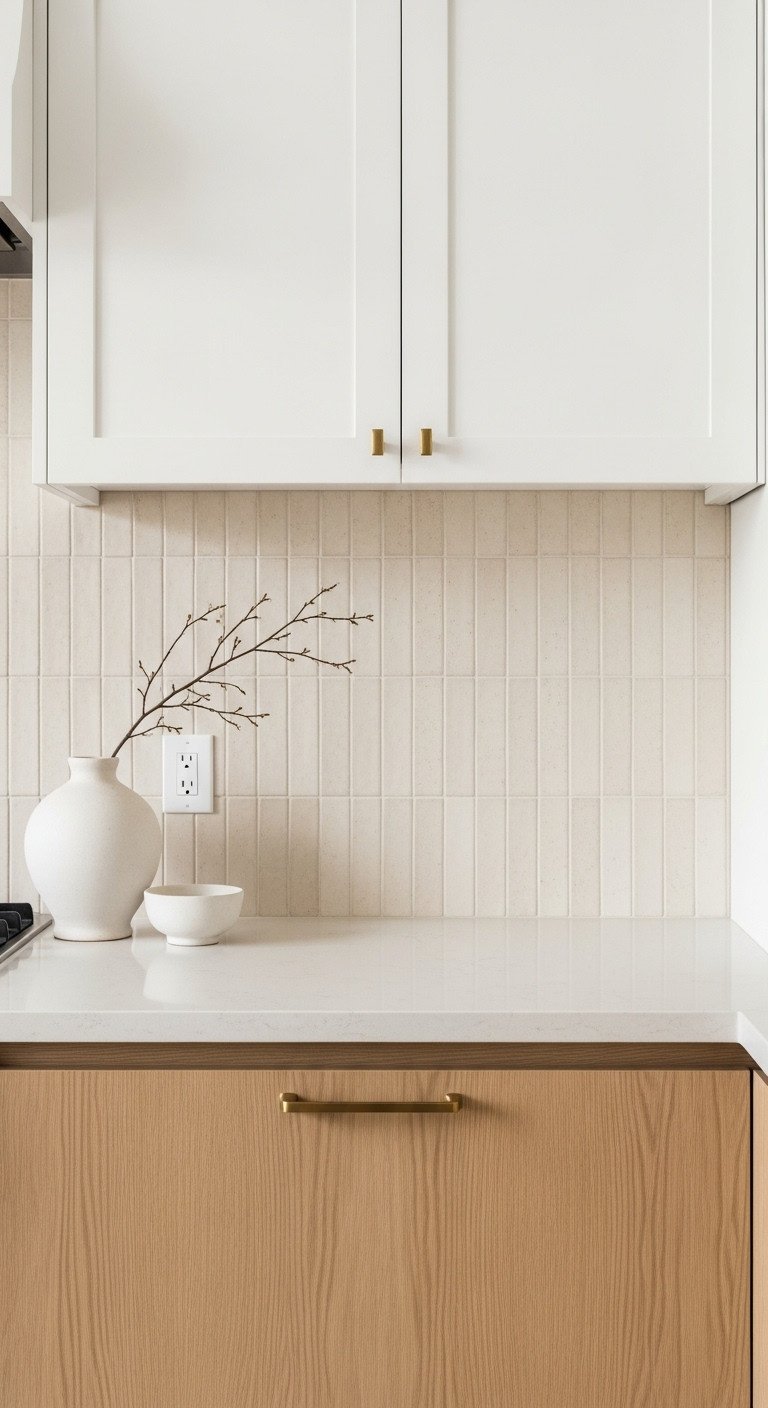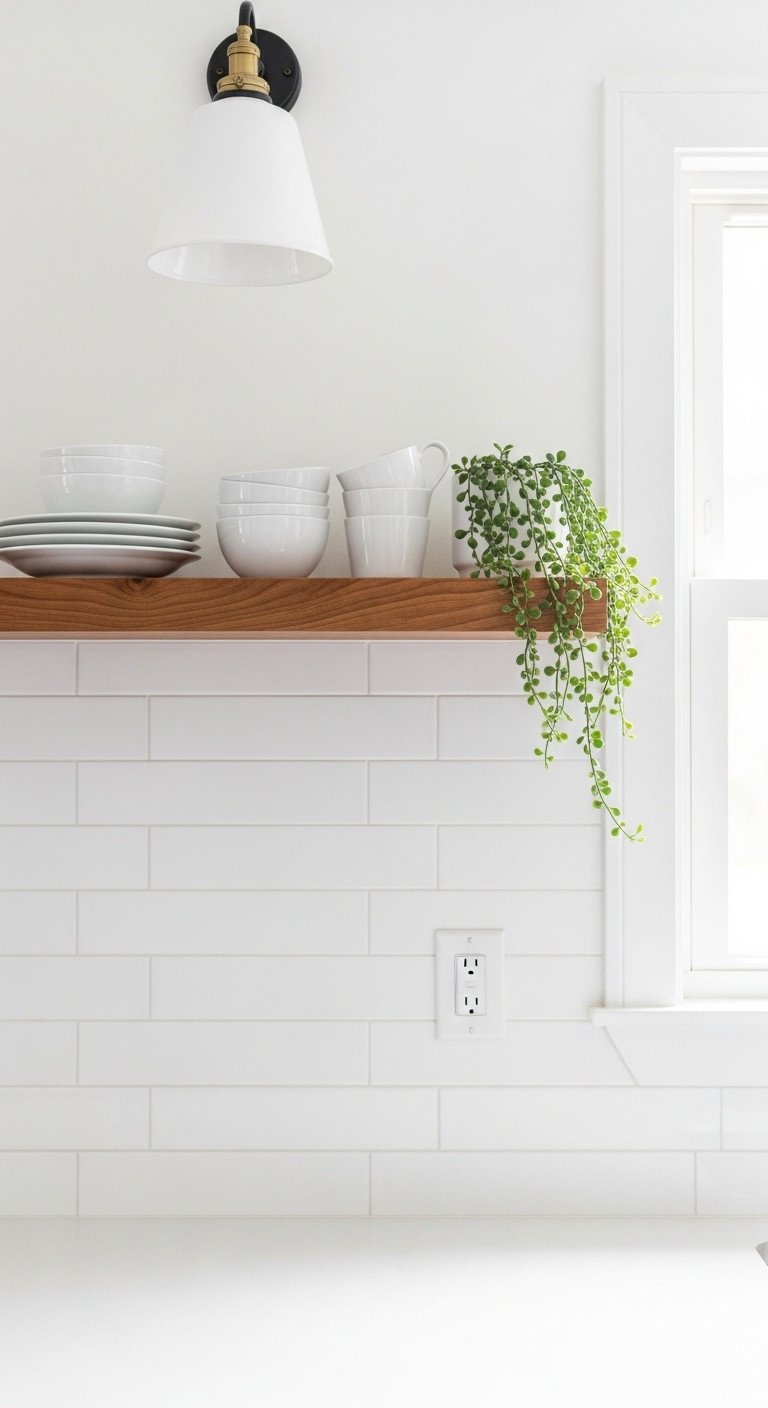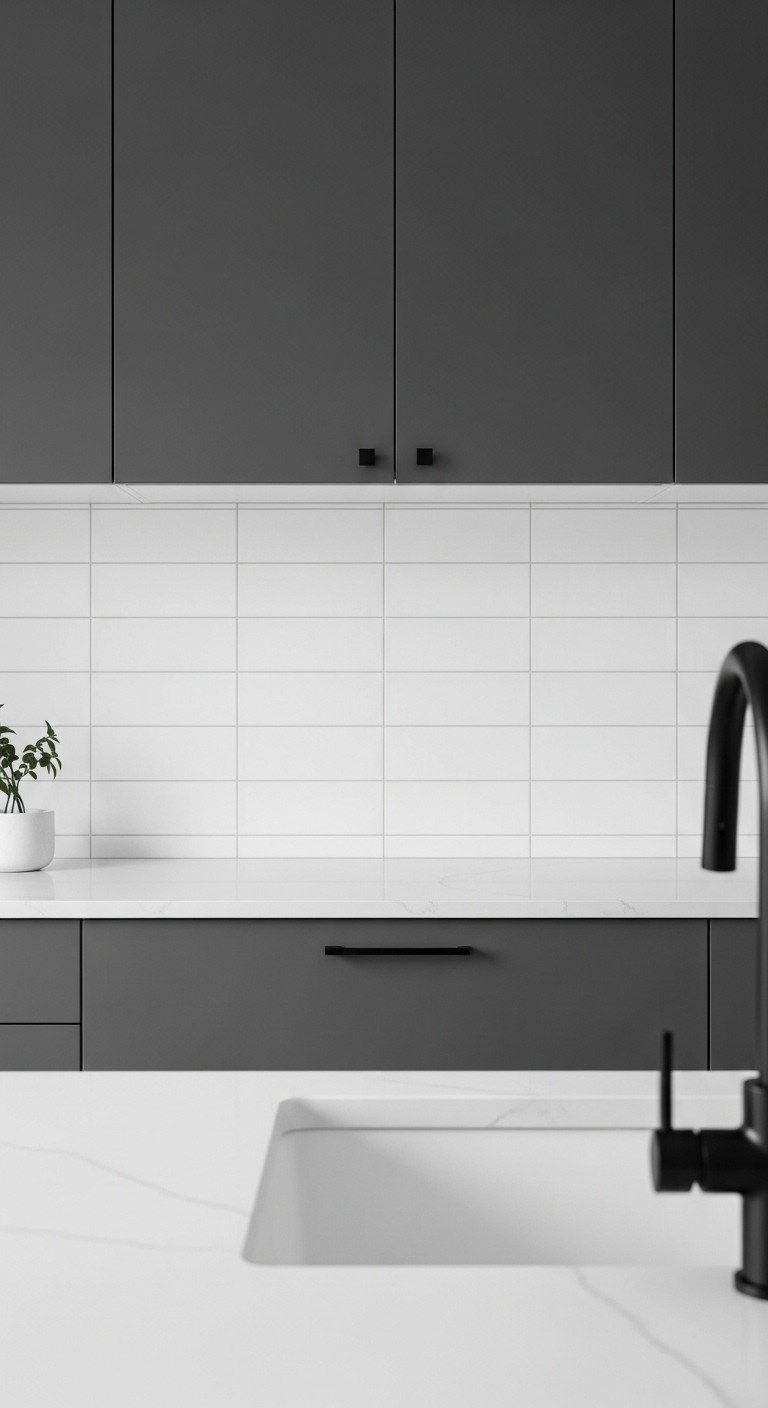As an Amazon Associate KitchenwareSets.com earns from qualifying purchases.
9 Zen Japanese Kitchen Backsplash Ideas For Your Home
Craving a kitchen that feels less like a chaotic workspace and more like a tranquil retreat? In our busy lives, the heart of the home can often become a source of stress—a cluttered, overwhelming space that adds to the noise rather than quieting it. You’re looking for an escape, a way to infuse your culinary space with a sense of calm and serenity, but you’re not sure where to start.
The endless scroll of generic kitchen designs can feel uninspiring. Many modern kitchens, while functional, lack soul and warmth. You desire a design that is both beautiful and mindful, blending clean, minimalist lines with the organic warmth of natural materials. The challenge is finding the perfect element that can single-handedly transform the entire atmosphere of your room without requiring a full-scale demolition.
A Japanese-inspired kitchen backsplash transforms your space into a serene haven by focusing on natural materials, clean lines, and a muted color palette. It blends the minimalism of Japanese design with the warmth of Scandinavian style, creating a look that is both tranquil and highly functional. This single design choice can serve as the focal point and foundation for creating the peaceful, zen-inspired kitchen you’ve been dreaming of.
Craving a Calm and Serene Kitchen? Here’s How to Create Your Zen-Inspired Escape
A Japanese-inspired kitchen backsplash is the key to transforming your culinary space into a serene haven. It achieves this by focusing on the core principles of Japanese design: natural materials, clean lines, and a calming, muted color palette. This approach doesn’t just update your kitchen; it changes its entire energy. By blending the profound simplicity of Japanese minimalism with the cozy warmth of Scandinavian comfort—a style known as Japandi—you create a look that is both deeply tranquil and exceptionally functional. This backsplash becomes more than just a protective surface; it’s a piece of functional art that sets the tone for the entire room, turning the heart of your home into a peaceful retreat.
The Core Principles of Japanese Backsplash Design
The best Japanese kitchen design focuses on simplicity (Kanso), natural materials (Shizen), the beauty of imperfection (Wabi-Sabi), and subtle elegance (Shibui). These foundational principles are not just abstract ideas; they directly guide the choices in materials like wood and ceramic and inspire a color palette of warm, muted tones that create a sense of peace and harmony. Understanding them is the first step to creating an authentic and serene space.
- Kanso (簡素): This is the principle of simplicity and the elimination of all that is not essential. For a backsplash, this translates to clean lines, uncluttered patterns, and a focus on the inherent beauty of the material itself, rather than ornate decoration.
- Shizen (自然): This emphasizes naturalness and a deep connection to the earth. A Shizen-inspired backsplash brings organic materials and textures into the kitchen, using elements like wood, stone, and handmade ceramics to reflect the patterns and colors of the natural world.
- Wabi-Sabi (侘寂): This philosophy finds profound beauty in imperfection, impermanence, and the authentic character of things. A wabi-sabi backsplash celebrates the unique variations in a handmade tile, the rough texture of a natural finish, or the subtle irregularities that give a surface its soul.
- Shibui (渋い): This refers to a particular aesthetic of simple, subtle, and unobtrusive beauty. A shibui backsplash is elegant without being flashy. Its beauty is quiet and deep, revealing itself slowly and providing a timeless quality that never feels dated.
9 Zen Japanese Kitchen Backsplash Ideas to Inspire Tranquility (2025)
Our curated list of 9 stunning Japanese kitchen backsplash ideas includes: 1. Japandi Style Zellige Tiles, 2. Natural Wood Accents, 3. Minimalist Large Format Tiles, 4. Traditional Glazed Ceramics, 5. Serene Glass Tiles, 6. Origami-Inspired Patterns, 7. Nature Motif Tiles, 8. Wabi-Sabi Rough Finishes, and 9. Modern Geometric Patterns. Each one of these concepts embodies the principles of Japanese design, offering a unique path to a more tranquil and beautiful kitchen. We’ve included visual inspiration and practical tips to help you bring these serene looks into your own home.
1. Embrace Harmony with a Japandi Style Backsplash

Save this harmonious Japandi idea to your ‘Dream Kitchen’ board!
Materials Needed: Zellige-style ceramic tiles, thin-set mortar, grout (in a matching neutral color), tile trowel, grout float, tile saw.
Step-by-Step Directions:
1. Select Your Tile: Choose a zellige-style tile in a soft, neutral tone like cream, beige, or light gray. The subtle imperfections and variations in glaze are key to this look.
2. Pair with Natural Wood: The backsplash should complement natural wood elements. This style pairs beautifully with white oak or light maple cabinets.
3. Layout: A simple stacked layout (either horizontal or vertical) enhances the clean lines central to both Japanese and Scandinavian design.
4. Installation: Apply a thin, even layer of mortar. Press each tile firmly into place, leaving minimal grout lines for a more seamless, organic look.
5. Grouting: Use a grout color that closely matches the tile to maintain a monolithic, serene appearance rather than a high-contrast grid.
Pro-Tip: Because zellige tiles have inherent irregularities, a traditional tile spacer may not work. Embrace a tight, hand-set joint to celebrate the tile’s natural, wabi-sabi character.
2. Connect with Nature Using Wood Elements

Pin this natural wood accent idea for a touch of warmth!
Materials Needed: Minimalist tiles (e.g., large format white ceramic), floating wood shelf kit, drill, level, stud finder, decorative items.
Step-by-Step Directions:
1. Create a Neutral Canvas: Install a simple, non-distracting backsplash using large format tiles in white or light gray. This creates a clean backdrop that allows the wood to stand out.
2. Choose Your Wood: Select a wood species with a warm, beautiful grain, like teak, acacia, or white oak. A thick, solid wood floating shelf makes a significant impact.
3. Strategic Placement: Install the floating shelf above the main splash zone, running parallel to the countertop. Use a stud finder and heavy-duty brackets to ensure it’s secure enough for dishware.
4. Seal for Protection: If the wood is close to the sink, ensure it is sealed with a high-quality waterproof polyurethane finish to protect it from moisture.
5. Style Minimally: Adorn the shelf with a few carefully chosen items—a small plant, handmade pottery, or simple white dishes—to maintain the uncluttered Japanese aesthetic.
Lesson Learned: Always check the load capacity of your floating shelf brackets. It’s better to over-engineer for strength than risk a shelf full of dishes collapsing.
3. Achieve Serenity with Clean Lines & Minimalist Tiles

Love minimalism? Save this clean and simple backsplash idea!
Materials Needed: Large format tiles (e.g., 12×24″ or larger), tile adhesive, grout that perfectly matches the tile color, tile leveling system.
Step-by-Step Directions:
1. Go Big: Select the largest format tile your space can accommodate. Larger tiles mean fewer grout lines, which is the key to a clean, monolithic look. A simple subway tile in a stacked bond pattern also works well.
2. Match Your Grout: This is the most crucial step. Use a high-quality grout that is professionally color-matched to your tile. The goal is to make the grout lines disappear.
3. Use a Leveling System: For large format tiles, using a tile leveling system (clips and wedges) is non-negotiable. It ensures a perfectly flat surface with no lippage, reinforcing the clean aesthetic.
4. Keep it Simple: Avoid decorative borders or accent tiles. The beauty of this style lies in its uninterrupted simplicity.
Pro-Tip: Before you buy, get a sample of your chosen tile and several grout color sticks. Apply the grout to the tile edge and let it dry to see the true final color before committing.
4. Add Character with Traditional Japanese Glazes
Pin this unique glazed tile idea for a touch of artisan craft!
Materials Needed: Artisan ceramic tiles, high-quality tile adhesive, grout, tile sealer (if recommended by manufacturer).
Step-by-Step Directions:
1. Source Your Tile: Look for tile manufacturers that specialize in Japanese-style ceramics, like INAX or Zen+Clay, or search for tiles described as having a “reactive” or “artisanal” glaze. The key is the variation in color and texture from piece to piece.
2. Choose a Soothing Color: Opt for gentle, warm shades created by traditional glazes—soft greens, warm grays, or creamy beiges—that evoke a soft, inviting impression.
3. Plan the Layout: Before installing, lay out your tiles on the floor to arrange the color variations in a pleasing, random pattern. This prevents unintentional splotches of darker or lighter tiles.
4. Professional Installation Recommended: Due to the variations in size and thickness common in handmade-look tiles, professional installation can help achieve the best result.
Pro-Tip: Order at least 15-20% more tile than you need. This overage is crucial for handmade tiles, allowing you to select the best pieces and account for cuts and potential breakage.
5. Create a Luminous Glow with Glass Tiles
Add this glowing glass tile idea to your kitchen inspiration board!
Materials Needed: Glass tiles (typically mesh-backed sheets), adhesive specifically for glass tiles, unsanded grout, notched trowel for glass.
Step-by-Step Directions:
1. Select a Soft Hue: Choose glass tiles in a tranquil color like a soft white, pale green, or light gray. A glossy finish will maximize the light-reflecting properties.
2. Use the Right Adhesive: This is critical. You must use a white, thin-set mortar specifically formulated for glass tiles. Regular gray mortar will show through and muddy the tile’s color.
3. Create a Smooth Surface: Ensure your wall is perfectly smooth before installation, as any imperfections can be seen through the glass.
4. Grout Carefully: Use unsanded grout to avoid scratching the glass surface during application.
Lesson Learned: When cutting glass tiles, score the front with a glass cutter and snap them cleanly. A wet saw with a diamond blade designed for glass provides the cleanest cuts for outlets and corners.
6. Form an Elegant Focal Point with Origami-Inspired Patterns
Save this elegant origami pattern for a true statement backsplash!
Materials Needed: Geometric or 3D shaped tiles, tile adhesive, appropriate grout, level, tile saw.
Step-by-Step Directions:
1. Find the Right Tile: Search for tiles with geometric shapes like triangles, diamonds, or hexagons that can be arranged into larger, repeating patterns reminiscent of origami or traditional Wagara patterns.
2. Designate a Focal Area: These intricate patterns work best as a feature, for example, in the area behind the cooktop, rather than across the entire kitchen.
3. Dry Fit First: Due to the complexity of the pattern, it’s essential to do a full “dry fit” on the floor or a large table. This allows you to perfect the layout and plan your cuts before applying any adhesive.
4. Start from the Center: Begin your installation from the absolute center of your focal wall and work your way outwards to ensure the pattern is perfectly symmetrical.
Pro-Tip: For 3D tiles, use a slightly thicker bed of adhesive to ensure the tile makes full contact with the wall, and be prepared for more complex grouting, as you’ll need to work it into many different angles.
7. Weave in Subtle Nature-Inspired Motifs
Pin this delicate nature-inspired idea for a touch of elegance.
Materials Needed: Field tiles, accent tiles with a nature motif OR patterned peel-and-stick tile sheets, utility knife, level.
Step-by-Step Directions:
1. Choose Your Motif: Decide on a subtle natural pattern—delicate cherry blossoms, a stylized wave (Seigaiha), bamboo, or leaves.
2. Option 1: Accent Tiles: For a high-end look, use a solid color field tile for most of the backsplash and randomly intersperse a few matching accent tiles with your chosen motif.
3. Option 2: Patterned Tile: Choose a tile where the pattern repeats across its surface, such as a Japanese wave pattern tile, for a more continuous design.
4. DIY-Friendly Option: For an easier, budget-friendly update, use a high-quality peel-and-stick backsplash that features a Japanese nature-inspired design. Ensure the wall is clean, smooth, and primed before application.
Pro-Tip: When using accent tiles, aim for a balanced, organic randomness. Avoid placing them in straight lines or obvious patterns. The goal is for them to be a delightful, unexpected discovery.
8. Find Beauty in Imperfection with a Wabi-Sabi Finish
Embrace imperfection! Save this unique wabi-sabi backsplash idea.
Materials Needed: Tiles with a rough or handmade finish (like some zellige, terracotta, or raku-fired tiles), mortar, wider grout joints, grout.
Step-by-Step Directions:
1. Select Tactile Tiles: Look for tiles described as having “rough edges,” “uneven surfaces,” or a “handmade” quality. Zellige or terracotta tiles are excellent choices for achieving this look.
2. Embrace Variation: The goal is to highlight the differences between each tile. Don’t discard tiles with unique glaze spots or slightly different shapes; these are the stars of the wabi-sabi aesthetic.
3. Wider Grout Lines: Unlike the minimalist style, wabi-sabi often benefits from slightly wider, more visible grout lines (around 1/8 inch). This frames each unique tile and adds to the overall textured look.
4. Consider a Grout Wash: A light “grout wash” or “smear” over the tile faces before the final cleanup can add a sense of age and patina. Test this on a spare tile first.
Pro-Tip: Seal unglazed terracotta or other porous wabi-sabi style tiles before grouting. This prevents the grout from staining the face of the tile, a process known as “grout haze.”
9. Introduce Modern Geometric Precision
Add this bold geometric idea to your ‘Modern Kitchen’ Pinterest board!
Materials Needed: Geometric tiles (e.g., hexagon, fan, or triangle), tile adhesive, grout (often a contrasting color), level, and a wet saw for precise cuts.
Step-by-Step Directions:
1. Choose a Strong Shape: Hexagon tiles are a popular choice, but also consider fish scale (fan) or triangle shapes for a modern yet organic feel. Concave surfaces add another layer of depth and light play.
2. Consider Contrast: This is a style where a contrasting grout color can be very effective. A light gray grout with a dark charcoal hex tile, for example, will emphasize the geometric pattern and precision.
3. Plan Your Edges: The most challenging part of installing shaped tiles is planning the edges where the backsplash ends or meets a cabinet. Use a tile trim profile for a clean, professional finish.
4. Precise Cuts are Key: A high-quality wet saw is essential for cutting geometric tiles accurately around outlets and corners to maintain the pattern’s integrity.
Lesson Learned: For complex shapes like hexagons, start your layout from the most visible centerline and work outwards. This ensures the pattern looks balanced and any partial tiles are less noticeable at the edges.
Key Takeaways: Your Quick Guide to Japanese Kitchen Backsplash
- Focus on Harmony: The best Japanese backsplashes create a sense of calm. Blend minimalism with warmth (Japandi) and connect to nature with wood or earthy tones.
- Texture is Key: Whether it’s the imperfect glaze of a wabi-sabi tile, the gloss of glass, or the 3D shape of an origami pattern, texture adds depth and character.
- Less is More: Embrace clean lines and uncluttered design. Choose one focal point—either a patterned tile or a natural material—and let it shine against a simple backdrop.
- Color Palette Matters: Stick to warm, muted, and natural tones like creams, soft grays, earthy browns, and gentle greens to promote a tranquil atmosphere.
People Also Ask About Japanese Kitchen Backsplash
Should your backsplash be lighter or darker than a countertop?
Traditionally, backsplashes are lighter than countertops to create an open, airy feel, similar to how walls are usually lighter than floors. However, there are no strict rules. A dark backsplash with a light countertop can create a stunning, dramatic focal point, while a monochrome scheme where both are similar in color can look timeless and serene.
What is the rule for a kitchen backsplash?
The primary functional rule is that a backsplash should protect the wall from splashes and heat, typically covering the area between the countertop and the bottom of the upper cabinets. Aesthetically, the rule is to create clean lines. For a cohesive look, the top of the backsplash should align perfectly with the bottom of your wall cabinets.
What backsplash never goes out of style?
Simple, high-quality ceramic subway tiles in a neutral color like white or light gray are a timeless choice that never goes out of style. Their versatility allows them to fit into countless design aesthetics, from traditional to modern minimalist. Natural stone looks and simple geometric patterns also have enduring appeal.
What does a typical kitchen look like in Japan?
A typical modern kitchen in Japan is often compact, highly efficient, and emphasizes natural materials and light. It features clean lines, uncluttered surfaces, and smart storage solutions. You’ll commonly see natural wood cabinetry, simple tile or stainless steel backsplashes, and a color palette of warm, muted tones like beige, white, and soft gray.
Final Thoughts
Choosing a Japanese-inspired backsplash is about more than just selecting a tile; it’s about making a conscious decision to create a feeling of tranquility and personal retreat in the heart of your home. Whether you are drawn to the harmonious blend of Japandi style, the rustic beauty of a wabi-sabi finish, or the clean precision of minimalist lines, the right backsplash will serve as a daily reminder to find peace in simplicity. Trust your instincts, embrace the principles of harmony and nature, and choose the design that brings you the most joy.
Which of these zen-inspired ideas speaks to you the most? Let us know in the comments below
Last update on 2025-10-14 at 22:55 / Affiliate links / Images from Amazon Product Advertising API
